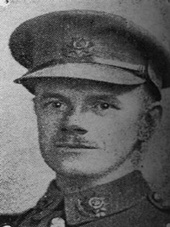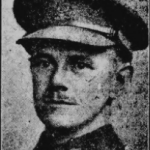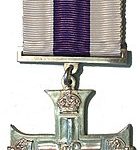
BORN HULL 1885. SON OF JOHN HUETSON EASTON & ELLEN F THOMPSON. HIS FATHER RAN EASTON & SONS, A WELL KNOWN FIRM OF AUCTIONEERS AND VALUERS. CAPTAIN EASTON WAS A FORMER ACCOUNTANT WORKING AT QUAY STREET. HE FORMED A BUSINESS PARTNERSHIP WITH MESSRS FAWLEY JUDGE, CHARTERED ACCOUNTANTS, IN 1910. HE WAS UNMARRIED & BOARDED AT 79 SPRING BANK, HULL AND WITH HIS SISTER, MAUD, AT 118 WESTBOURNE AVENUE, HULL.
HE HAD SERVED WITH THE EAST YORKSHIRE TERRITORIALS FOR MANY YEARS AND WAS KNOWN AS A FEARLESS OFFICER. HE HAD RECEIVED THREE WOUNDS IN THE WAR AND WAS PRESENTED WITH THE MILITARY CROSS, BY THE KING, ON 22ND MARCH 1916. HE HAD LEFT FOR FRANCE WITH COLONEL SHAW’S “FIGHTING FOURTHS”, IN APRIL 1915. WOUNDED THREE TIMES ON THE 3RD MAY AT YPRES. AN INDOMITABLE SPIRIT AND CHERFUL DISPOSITION, HE REMAINED UNDAUNTED. INVALIDED TO ENGLAND. HE RETURNED TO FRANCE AND WAS ATTACHED TO THE DUKE OF WELLINGTON’S WEST RIDING REGIMENT FOR SIX MONTHS. HE WAS KILLED IN ACTION, ON 23/04/1917, AGED 32.
HIS DEATH WAS REPORTED IN THE HULL DAILY MAIL ON 27TH APRIL 1917, WITH HIS PHOTOGRAPH. * HE IS BURIED AT WANCOURT BRITISH CEMETERY
HE CAME FROM A MILITARY FAMILY. HIS BROTHER, GEORGE EASTON, WAS COLONEL OF THE EAST RIDING TERRITORIAL FORCE. ANOTHER BROTHER, LT/COL, ARTHUR EASTON SERVED IN THE SAME REGIMENT AND WAS WOUNDED AT THE SAME TIME. ANOTHER, BROTHER, CAPTAIN, HAROLD EASTON WAS ON ACTIVE SERVICE.
CAPTAIN, CYRIL EASTON IS LISTED ON THE HYMER’S COLLEGE MEMORIAL. A MEMORIAL WALL PLAQUE WAS DEDICATED TO HIM AND HIS BROTHER, AT HULL MINSTER.
Arras Battle, April 1917 – The 1/4th East Yorkshires did not go into the line until 15 April, when they moved up from Arras in support. The battalion led the division’s attack at the Second Battle of the Scarpe, which began on 23 April. The 1/4th East Yorkshires and 1/4th Green Howards went forward at Zero hour (04.45) with ‘great dash’, supported by tanks of A Section, 10 Company, D Battalion, Tank Corps. The infantry got too close to their own barrage, which was creeping forward too slowly. Despite serious casualties, especially among officers, they captured the first objective (the Blue Line) on time, apart from the centre, where a party of the enemy held out in a copse on the Chérisy–Guémappe road. However, A Company took the copse by 08.00 with the help of tank D3, and dug in on its eastern side. A mixed party of D, A and B companies captured a battery of German 7.7 cm field guns near the copse. By now the battalion only had three officers and 200 men in the line, with their flanks ‘in the air’, and were almost surrounded when the German counter-attacks began. The battalion was forced back to its starting line, the captured guns lost, though they had already sent back some hundreds of German prisoners. The second tank (D4, ‘Diana’) covered the retirement with its 6-pdr guns until repeatedly hit by anti-tank rifles and set on fire. The objectives were retaken by a follow-up attack by 50th (N) Division later in the day. The battalion’s losses in this action were 17 officers and 352 other ranks. The remnants marched back to Arras and reorganised as two companies.
50th (N) Division was pulled back into reserve in May 1917, and then returned to trench-holding in June. 1/4th East Yorkshires absorbed reinforcements and resumed its four-company organisation. On 26/27 June it was in support for a minor attack, and C Company and a platoon of D Company took over the captured line at dusk on 27 June. However, the Germans put down a heavy bombardment at 07.00 the next morning, which continued all day until they counter-attacked at 16.30. By then C Company had lost 75 per cent of its men, and it and the D Company platoon were forced back. The line was strengthened by other troops, but 1/4th East Yorkshires had lost 106 officers and men, killed, wounded and missing. Although it was not involved in the early stages of the Flanders Offensive (the Third Battle of Ypres), there was active Trench warfare along the division’s front throughout the summer, with trench raiding and gas attacks. In October the division was relieved and after 10 days’ training at Achiet-le-Petit it moved to the Ypres sector.

